2005 SUBARU BAJA gas type
[x] Cancel search: gas typePage 47 of 469
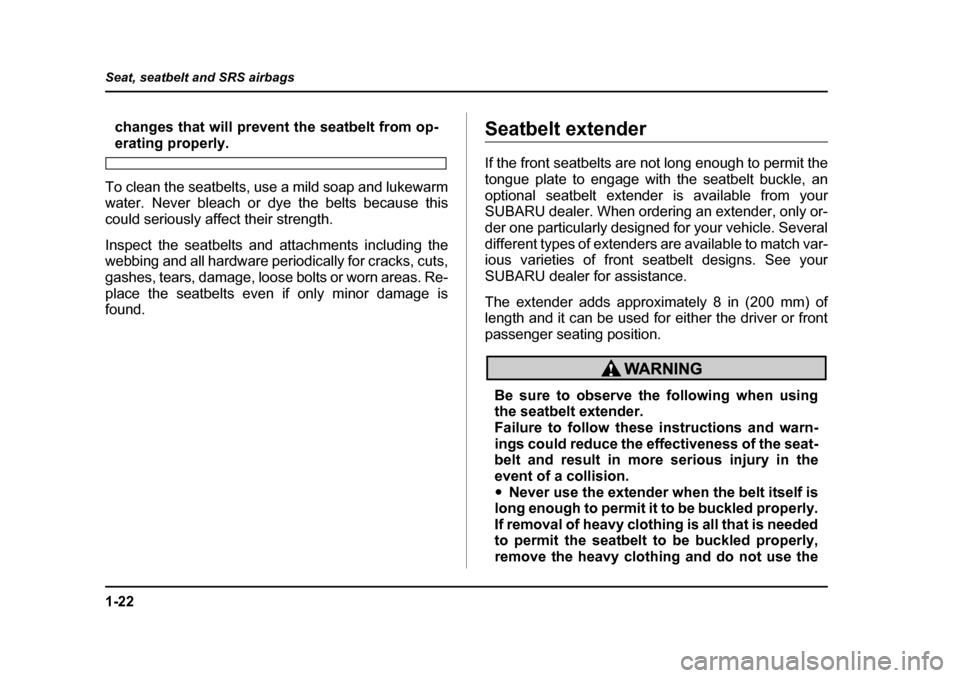
1-22
Seat, seatbelt and SRS airbags
changes that will prevent the seatbelt from op-
erating properly.
To clean the seatbelts, use a mild soap and lukewarm
water. Never bleach or dye the belts because this
could seriously affect their strength.
Inspect the seatbelts and attachments including the webbing and all hardware periodically for cracks, cuts,
gashes, tears, damage, loose bolts or worn areas. Re-
place the seatbelts even if only minor damage is
found.Seatbelt extender
If the front seatbelts are not long enough to permit the
tongue plate to engage with the seatbelt buckle, an
optional seatbelt extender is available from your
SUBARU dealer. When ordering an extender, only or-
der one particularly designed for your vehicle. Several
different types of extenders are available to match var-
ious varieties of front seatbelt designs. See your
SUBARU dealer for assistance.
The extender adds approximately 8 in (200 mm) of
length and it can be used for either the driver or front
passenger seating position.
Be sure to observe the following when using
the seatbelt extender.
Failure to follow these instructions and warn-
ings could reduce the effectiveness of the seat-
belt and result in more serious injury in the
event of a collision.�y Never use the extender when the belt itself is
long enough to permit it to be buckled properly.
If removal of heavy clothing is all that is needed
to permit the seatbelt to be buckled properly,
remove the heavy clothing and do not use the
Page 147 of 469
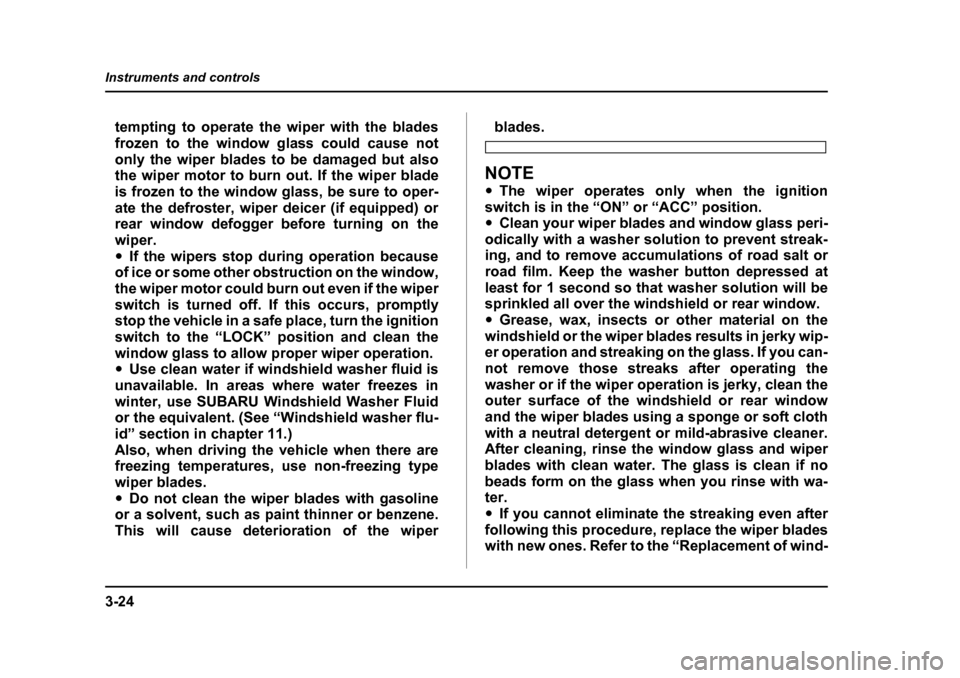
3-24
Instruments and controls
tempting to operate the wiper with the blades
frozen to the window glass could cause not
only the wiper blades to be damaged but also
the wiper motor to burn out. If the wiper blade is frozen to the window glass, be sure to oper-
ate the defroster, wiper deicer (if equipped) or
rear window defogger before turning on the
wiper.�y
If the wipers stop during operation because
of ice or some other obstruction on the window,the wiper motor could burn out even if the wiper
switch is turned off. If this occurs, promptly
stop the vehicle in a safe place, turn the ignition
switch to the “LOCK” position and clean the
window glass to allow proper wiper operation. �y Use clean water if windshield washer fluid is
unavailable. In areas where water freezes in
winter, use SUBARU Windshield Washer Fluid
or the equivalent. (See “Windshield washer flu-
id” section in chapter 11.)
Also, when driving the vehicle when there are
freezing temperatures, use non-freezing type
wiper blades.�y Do not clean the wiper blades with gasoline
or a solvent, such as paint thinner or benzene.
This will cause deterioration of the wiperblades.
NOTE �y The wiper operates only when the ignition
switch is in the “ON” or “ACC” position. �y Clean your wiper blades and window glass peri-
odically with a washer solution to prevent streak-
ing, and to remove accumulations of road salt or
road film. Keep the washer button depressed at
least for 1 second so that washer solution will be
sprinkled all over the windshield or rear window. �y Grease, wax, insects or other material on the
windshield or the wiper blades results in jerky wip-
er operation and streaking on the glass. If you can-
not remove those streaks after operating the
washer or if the wiper operation is jerky, clean the
outer surface of the windshield or rear window
and the wiper blades using a sponge or soft cloth
with a neutral detergent or mild-abrasive cleaner.
After cleaning, rinse the window glass and wiper
blades with clean water. The glass is clean if no
beads form on the glass when you rinse with wa-ter. �y If you cannot eliminate the streaking even after
following this procedure, replace the wiper blades
with new ones. Refer to the “Replacement of wind-
Page 238 of 469

7-3
Starting and operating
– CONTINUED –
California is permitted to have higher sulfur levels,
which may affect the performance of your vehicle’s
catalytic converter and may produce a sulfur exhaust
odor or smell. SUBARU recommends that you try a
different brand of unleaded gasoline having lower sul-
fur to determine if the problem is fuel related before re-
turning your vehicle to an authorized dealer for ser-
vice. �TMMT
Some gasoline contains an octane-enhancing additive
called MMT (Methylcyclopentadienyl Manganese Tri-
carbonyl). If you use such fuels, your emission control
system performance may deteriorate and the CHECK
ENGINE warning light/Malfunction indicator lamp may
turn on. If this happens, return to your authorized
SUBARU Dealer for service. If it is determined that the
condition is caused by the type of fuel used, repairs
may not be covered by your warranty. �T Gasoline for cleaner air
Your use of gasoline with detergent additives will help
prevent deposits from forming in your engine and fuel
system. This helps keep your engine in tune and your
emission control system working properly, and is a
way of doing your part for cleaner air. If you continu-
ously use a high quality fuel with the proper detergent
and other additives, you should never need to add any fuel system cleaning agents to your fuel tank.
Many gasolines are now blended with materials called
oxygenates. Use of these fuels can also help keep the
air cleaner. Oxygenated blend fuels, such as MTBE
(Methyl Tertiary Butyl ether) or ethanol (ethyl or grain
alcohol) may be used in your vehicle, but should con-
tain no more than 15% MTBE or 10% ethanol for the
proper operation of your SUBARU.
In addition, some gasoline suppliers are now produc-
ing reformulated gasoline, which is designed to reduce
vehicle emissions. SUBARU approves the use of re-
formulated gasoline.
If you are not sure what the fuel contains, you should
ask your service station operators if their gasoline con-
tains detergents and oxygenates and if they have
been reformulated to reduce vehicle emissions.
As additional guidance, only use fuels suited for your
vehicle as explained below. �y
Fuel should be unleaded and have an octane rating
no lower than that specified in this manual. �y Methanol (methyl or wood alcohol) is sometimes
mixed with unleaded gasoline. Methanol can be used
in your vehicle ONLY if it does not exceed 5% of the
fuel mixture AND if it is accompanied by sufficient
quantities of the proper cosolvent and corrosion inhib-
Page 307 of 469
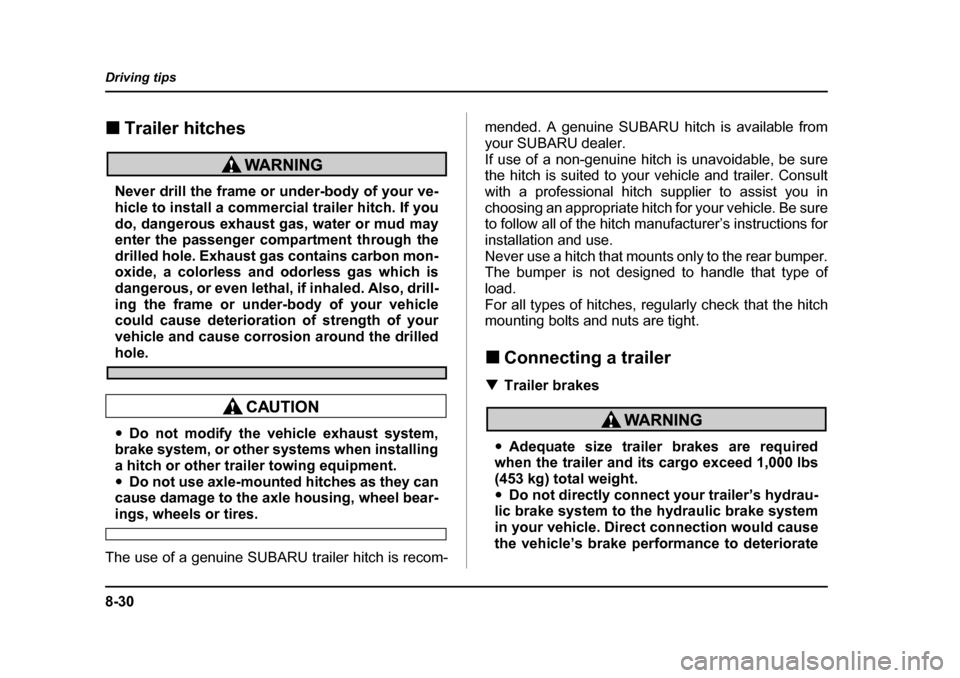
8-30
Driving tips
�„
Trailer hitches
Never drill the frame or under-body of your ve-
hicle to install a commercial trailer hitch. If you
do, dangerous exhaust gas, water or mud may
enter the passenger compartment through the
drilled hole. Exhaust gas contains carbon mon-
oxide, a colorless and odorless gas which is
dangerous, or even lethal, if inhaled. Also, drill-
ing the frame or under-body of your vehicle
could cause deterioration of strength of your
vehicle and cause corrosion around the drilled
hole.
�yDo not modify the vehicle exhaust system,
brake system, or other systems when installing
a hitch or other trailer towing equipment. �y Do not use axle-mounted hitches as they can
cause damage to the axle housing, wheel bear-
ings, wheels or tires.
The use of a genuine SUBARU trailer hitch is recom- mended. A genuine SUBARU hitch is available from your SUBARU dealer.
If use of a non-genuine hitch is unavoidable, be sure
the hitch is suited to your vehicle and trailer. Consult
with a professional hitch supplier to assist you in
choosing an appropriate hitch for your vehicle. Be sure
to follow all of the hitch manufacturer’s instructions for
installation and use.
Never use a hitch that mounts only to the rear bumper.
The bumper is not designed to handle that type of
load.
For all types of hitches, regularly check that the hitch
mounting bolts and nuts are tight. �„
Connecting a trailer
�T Trailer brakes
�yAdequate size trailer brakes are required
when the trailer and its cargo exceed 1,000 lbs
(453 kg) total weight.�y Do not directly connect your trailer’s hydrau-
lic brake system to the hydraulic brake system
in your vehicle. Direct connection would cause
the vehicle’s brake performance to deteriorate
Page 350 of 469
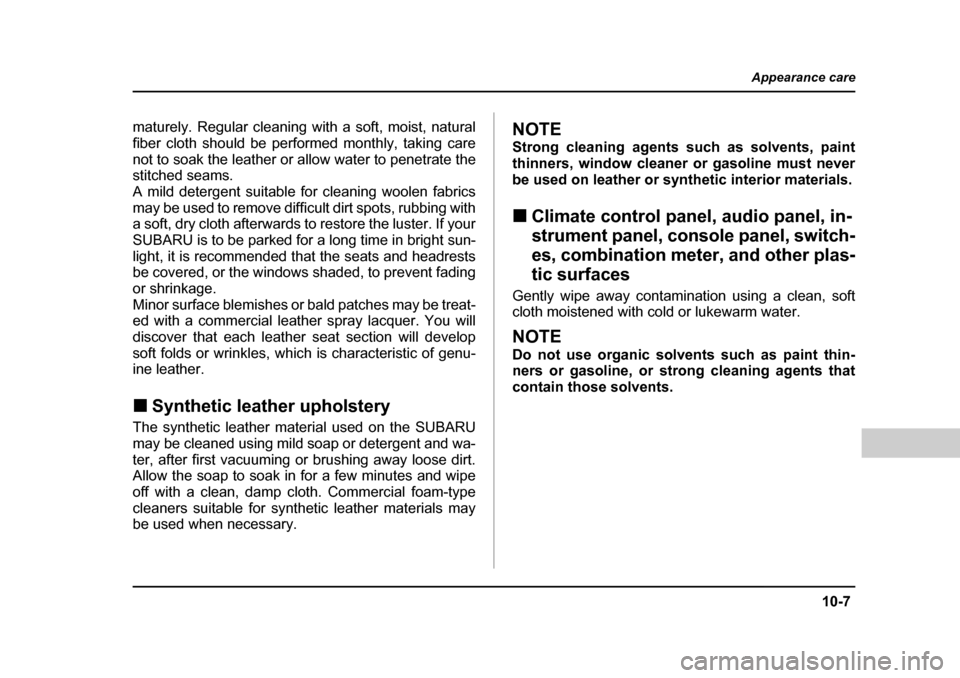
10-7
Appearance care
– CONTINUED –
maturely. Regular cleaning with a soft, moist, natural
fiber cloth should be performed monthly, taking care
not to soak the leather or allow water to penetrate the
stitched seams.
A mild detergent suitable for cleaning woolen fabrics
may be used to remove difficult dirt spots, rubbing with
a soft, dry cloth afterwards to restore the luster. If your
SUBARU is to be parked for a long time in bright sun-
light, it is recommended that the seats and headrests
be covered, or the windows shaded, to prevent fading
or shrinkage.
Minor surface blemishes or bald patches may be treat-
ed with a commercial leather spray lacquer. You will
discover that each leather seat section will develop
soft folds or wrinkles, which is characteristic of genu-
ine leather. �„Synthetic leather upholstery
The synthetic leather material used on the SUBARU
may be cleaned using mild soap or detergent and wa-
ter, after first vacuuming or brushing away loose dirt.
Allow the soap to soak in for a few minutes and wipe
off with a clean, damp cloth. Commercial foam-type
cleaners suitable for synthetic leather materials may
be used when necessary.NOTE
Strong cleaning agents such as solvents, paint
thinners, window cleaner or gasoline must never
be used on leather or synthetic interior materials. �„ Climate control panel, audio panel, in-
strument panel, console panel, switch-
es, combination meter, and other plas-tic surfaces
Gently wipe away contamination using a clean, soft
cloth moistened with cold or lukewarm water.
NOTE
Do not use organic solvents such as paint thin-
ners or gasoline, or strong cleaning agents that
contain those solvents.
Page 404 of 469
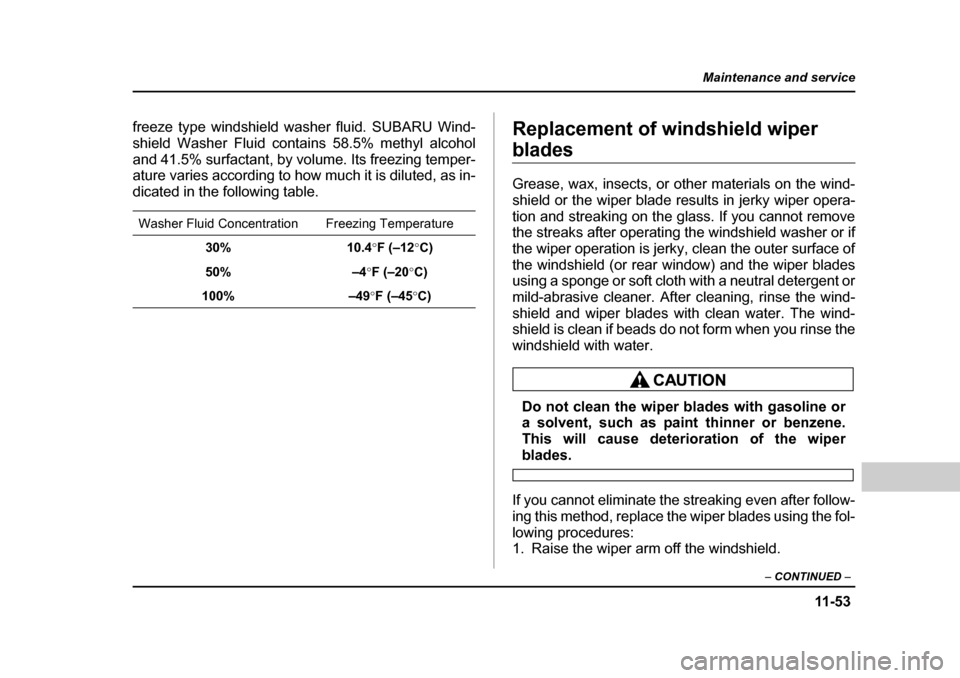
11 -5 3
Maintenance and service
– CONTINUED –
freeze type windshield washer fluid. SUBARU Wind-
shield Washer Fluid contains 58.5% methyl alcohol
and 41.5% surfactant, by volume. Its freezing temper-
ature varies according to how much it is diluted, as in-
dicated in the following table. Replacement of windshield wiper
blades
Grease, wax, insects, or other materials on the wind-
shield or the wiper blade results in jerky wiper opera-
tion and streaking on the glass. If you cannot remove
the streaks after operating the windshield washer or if
the wiper operation is jerky, clean the outer surface of
the windshield (or rear window) and the wiper blades
using a sponge or soft cloth with a neutral detergent or
mild-abrasive cleaner. After cleaning, rinse the wind-
shield and wiper blades with clean water. The wind-
shield is clean if beads do not form when you rinse the
windshield with water.
Do not clean the wiper blades with gasoline or
a solvent, such as paint thinner or benzene.
This will cause deterioration of the wiper
blades.
If you cannot eliminate the streaking even after follow-
ing this method, replace the wiper blades using the fol-
lowing procedures:
1. Raise the wiper arm off the windshield.
Washer Fluid Concentration Freezing Temperature
30% 10.4 °F (–12 °C)
50% –4 °F (–20 °C)
100% –49 °F (–45 °C)
Page 433 of 469

12-2
Specifications
SpecificationsSpecifications
These specifications are subject to change without notice. �„
Dimensions
in (mm)
�„ Engine
ModelBAJA, BAJA-SportBAJA-Turbo
Overall length199.3 (4,910)
Overall width70.1 (1,780)
Overall height62.1 (1,760)62.6 (1,775)
Wheelbase104.3 (2,650)
TreadFront57.7 (1,465)
Rear57.7 (1,465)
Ground clearance8.4 (213)
ItemNon-turboTurbo
Engine modelEJ251EJ255
Engine typeHorizontally opposed, liquid cooled 4 cylinder, 4 stroke gasoline engine
Displacement cc (cu-in)2,457 (150)
Bore × Stroke in (mm)3.92 × 3.11 (99.5 × 79.0)
Compression ratio10.0 : 18.2 : 1
Firing order1 - 3 - 2 - 4